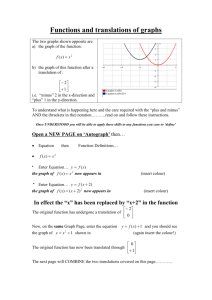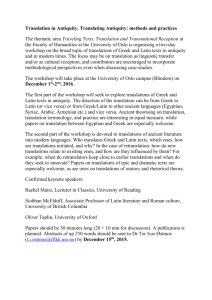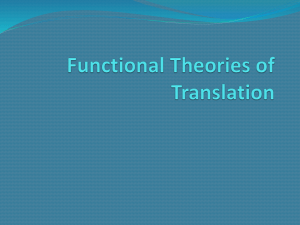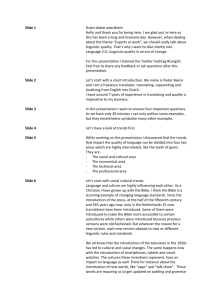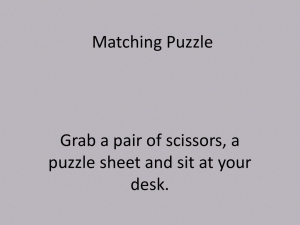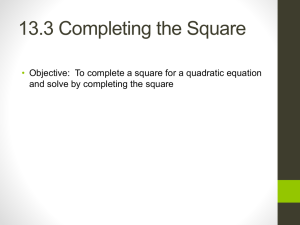Completing the square
advertisement
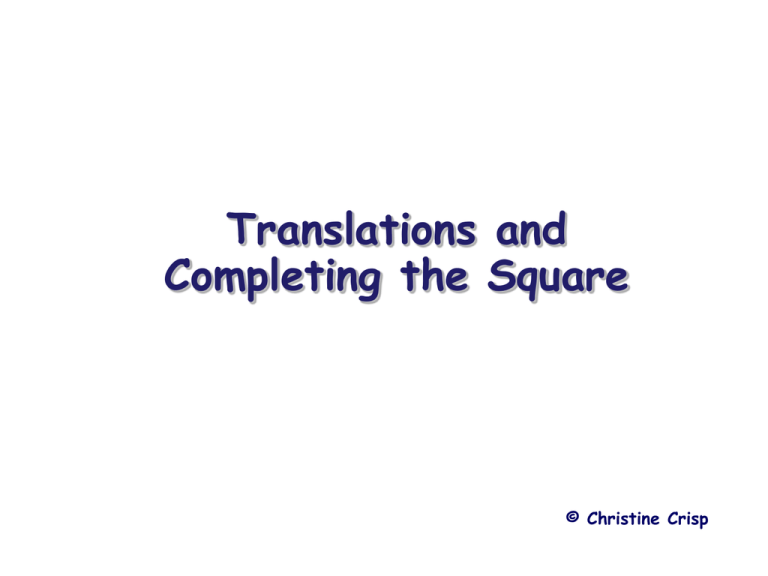
Translations and Completing the Square © Christine Crisp Translations The graph of parabola yx 2 forms a curve called a y x2 This point . . . is called the vertex Translations Adding a constant translates y x up the y-axis y x2 y x2 3 e.g. 2 y x2 y x2 3 y x2 The vertex is now ( 0, 3) y x 2 y x 3 2 has added 3 to the y-values Translations Adding 3 to x gives y x2 We get y ( x 3) 2 y x2 y ( x 3) 2 Adding 3 to x moves the curve 3 to the left. This may seem surprising but on the x-axis, y = 0 so, y0 0 ( x 3) 2 x 3 Translations Translating in both directions 2 2 y x y (x 5 ) 3 e.g. y (x 5) 2 3 y x2 We can write this in vector form as: translation 5 3 Translations SUMMARY The curve y ( x p) q 2 is a translation of y x 2 by The vertex is given by ( p, q) p q Translations Exercises: Sketch the following translations of y x 2 2 2 y x y (x 2 ) 1 1. y x2 y ( x 2)2 1 2. y x 3. 2 y (x 3) 2 y ( x 3)2 2 2 y x2 y x 2 y (x 4) 2 3 y x2 y ( x 4)2 3 Translations y x2 Sketch the following translations of 2 2 y x y (x 2 ) 1 1. y x2 y ( x 2)2 1 Now insert a coefficient infront of the bracket y x 2 y 2( x 2) 1 2 5 ^| Y 4 y 2( x 2)2 1 3 y x2 2 The 2 outside the bracket has stretched the curve vertically by a factor of 2 y ( x 2) 1 1 2 -4 -3 -2 -1 0 -1 -2 1 2 X-> 3 Translations 4 Sketch the curve found by translating y x by 2 2 3 . What is its equation? y (x 2) 2 3 5 Sketch the curve found by translating y x 2 1 by . 2 What is its equation? y (x 1) 2 2 Translations and Completing the Square A quadratic function which is written in the form y ( x p) 2 q is said to be in its completed square form. We often multiply out the brackets as follows: e.g. y (x 5) 2 3 This means multiply ( x – 5 ) by itself y ( x 5)( x 5) 3 So y x 2 5 x 5 x 25 3 y x 2 10x 28 y (x 5) 3 x 10 x 28 2 2 Completing the Square The completed square form of a quadratic function • writes the equation so we can see the 2 translation from y x • gives the vertex Completing the Square e.g. Consider y x translated by 2 to the left and 3 up. We can write this in vector form as: 2 translation 3 The equation of the curve is 2 y (x 2) 3 2 Completed square form Check: The vertex is ( -2, 3) Completing the Square Any quadratic expression which has the form ax2 + bx + c can be written as p(x + q)2 + r 2x2 + 4x + 5 = 2(x + 1)2 + 3 This can be checked by multiplying out the bracket 2(x + 1)2 + 3 = 2(x + 1)(x + 1) + 3 = 2(x2 + x + x + 1) + 3 = 2x2 + 4x + 2 + 3 = 2x2 + 4x + 5 Completing the Square 2x2 + 4x + 5 = p(x + q)2 + r = 2(x + 1)2 + 3 We need to find the values of p, q and r If the graph is plotted we find that the vertex is at (–1, 3) The graph has a Horizontal translation of –1 so q = +1 Opposite sign Vertical translation of 3 Same Sign so r = 3 p = coefficient of x2 p=2 So 2x2 + 4x + 5 = p(x + q)2 + r = 2(x + 1)2 + 3 Completing the Square Using a Calculator to Complete the Square 1) Plot the given curve in y1 2) Use the window button to set the scale so that the vertex is clearly visible 3) Use the 2ndF Trace button (Calc) to find the vertex – either a maximum or a minimum 4) Fill in the horizontal translation q 5) Fill in the vertical translation r 6) Fill in the vertical stretch using the coefficient of x2 Completing the Square Ex1 y = 2x2 – 3x – 5 Express in the form p(x + q)2 + r 5 ^| Y 4 Y=2x^2-3x-5 3 Using 2ndF Trace button (Calc) to find the vertex Min at x = 0.75 and y = –6.125 Horizontal translation of + 0.75 so q = –0.75 Opposite sign 2 1 -2 -1 0 -1 -2 -3 -4 -5 -6 -7 Vertical translation of –6.125 so r = –6.125 Same Sign p = coefficient of x2 = 2 So 2x2 – 3x – 5 = 2(x – 0.75)2 – 6.125 -8 -9 1 2 3 X-> 4 Completing the Square Ex1 y = 4 – 3x – x2 Express in the form p(x + q)2 + r 9 ^| Y 8 Y=4-3x-x^2 Using 2ndF Trace button (Calc) to find the vertex Max at x = –1.5 and y = 6.25 7 6 5 4 3 Horizontal translation of –1.5 so q = 1.5 Opposite sign 2 1 -4 -3 -2 -1 0 -1 Vertical translation of 6.25 Same Sign so r = 6.25 p = coefficient of x2 = –1 So 4 – 3x – x2 = –1(x + 1.5)2 + 6.25 -2 -3 1 2 3 X-> 4 Completing the Square Exercises Complete the square for the following quadratics: 1. x 2 4x 6 (x 2) 2 2 2. x 4x 3 (x 2) 2 7 3. x 2 6 x 10 (x 3) 2 1 2 Completing the Square 4. x 8x 2 (x 4) 2 18 5. x 2 3x 3 (x 32 ) 2 43 6. 2x 2 8x 1 2(x 2) 2 7 2 Qu.s in notes pg 32
